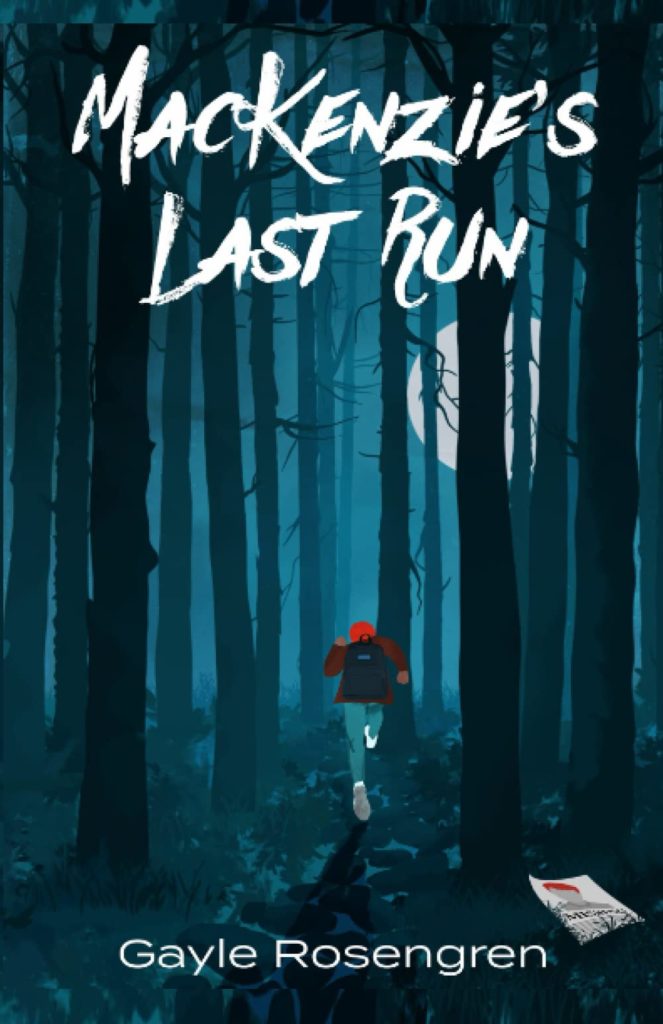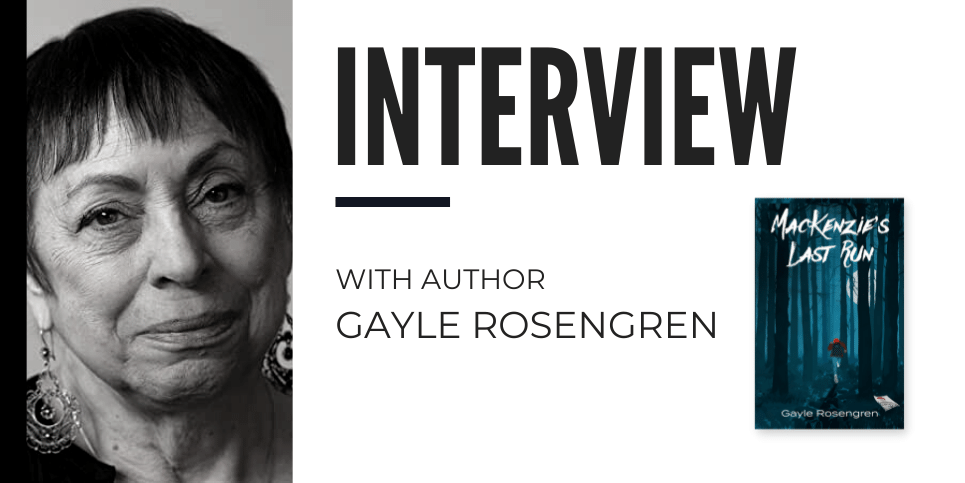The Children’s Book Review Interview in partnership with Gayle Rosengren, author of MacKenzie’s Last Run
MacKenzie’s Last Run is well-written, thought-provoking, and well-worth reading. Written from the alternating perspectives of the twin protagonists, this story is fast-paced, emotionally hard-hitting, and impossible to put down until the last page. In this insightful interview, author Gayle Rosengren poignantly discusses themes of grief, loss, and gun safety issues.
Dr. Jen Harrison: This novel is extremely hard-hitting. Can you tell us why it was important to you to write about the themes of grief and gun violence for the book?
Gayle Rosengren: Writing about grief came first. I’ve struggled my way through it more than once. I know what a dark and lonely place it can be. It’s a normal reaction to loss, but it’s also a “sad” topic so people tend to avoid talking about it. I wanted to engage readers in a “discussion” about loss in a safe, fictional space, stressing the importance of communication for healing. Gun violence is becoming so alarmingly frequent in our society that it seemed a perfect opportunity to shine a light on that issue at the same time by making it the cause of Dad’s death.
MacKenzie’s inability to compromise with his family is one of the main drivers of the story. What do you think readers can learn from the novel about family relationships?
Communication is vital to the quality of any relationship but it’s especially important within a family, and it is vital when a family is trying to absorb a painful event, such as the loss of a loved one. People do process grief differently and most of it is done internally over time. Sadness is natural. But when the grief gets worse instead of easing, when it creates distance from others rather than strengthening supportive ties, it’s a sign that professional help may be needed, especially in the case of a child.
Are any of the events in the narrative drawn from real-life experiences?
My first husband died when our youngest daughter was 12. He had battled cancer with therapies for a year but even though we knew from the beginning he was unlikely to survive, we were still shocked when he died following hospitalization of only three days. It made me imagine how much more shocking such a loss would be if it came with no warning at all, out of the blue on an ordinary day, and not as the result of an illness, but for no reason at all except a madman with a gun. I thought how much harder that must be to accept. There’s no opportunity to say goodbye. To say, “I’m sorry.” To say, “I love you.”
My daughter had a very hard time dealing with the loss of her father. She modeled Mac’s withdrawal behavior and his acting out—and she didn’t have Mac’s feeling of guilt to complicate and intensify her grief.
MacKenzie takes a very negative view of his therapist until the very last page of the novel. In honor of National Mental Health Awareness month, can you share any words of wisdom for readers who might be struggling with similar views?
I think for people suffering severe emotional pain, the thought of putting that pain into words to a stranger can be so uncomfortable they instinctively pull back. And if that pain is tied in any way to guilt, the thought of expressing that guilt to anyone is so shameful they are even more resistant. Mac puts down the therapist so he can justify not talking to him. But he eventually sees that things only get worse if they are left to fester inside, and he is able to take the first steps toward healing by finally opening up to the doctor—letting him in.
Guilt and shame also are demonstrated through his lack of interactions with his family, distancing himself from his mother and eventually even his twin, whom he’d always been so close to. People—especially young people—who are suffering from depression aren’t always good judges of what’s best for them. They often need a caring friend or family member or doctor to nudge them in the direction of a mental health professional for help.
Religion plays a key role in resolving the crisis in the novel; what do these elements of the story offer to readers who do not necessarily share in the Christian faith?
Because I anticipate that this book will have readers from diverse backgrounds, I was careful to avoid promoting any particular organized religion in the story. I do, however, allow for the existence of a spiritual element–a spiritual element that transcends any particular faith but that I think would be acceptable to all of them.
Mac in his delirium thinks he’s died, and from things he overhears thinks he’s in heaven because that’s his generic frame of reference for an afterlife. But neither he nor his father nor Tessa are “believers” in a Christian sense. When Tessa tries to pray, she is left feeling frustrated. She only takes comfort from action. And it’s her action that resolves the crisis. Not religion. Not prayer. It’s her deep and desperate love for Mac that restores their twin connection and enables her to find him just in time.
ESP also appears in the story’s resolution; can you tell us a little bit about the significance of the supernatural in the story?
I’ve always been fascinated by the stories some twins tell of having a “special” connection, knowing what the other one is feeling and thinking in key moments, and I think a lot of kids share that fascination. Call it ESP or genetic linking, it’s been proven to exist. I wanted to show how even the very strong relationship and the tie between Mac and Tessa broke down when their hurt and anger stopped them from talking to each other. It was only when they were both frightened into realizing how much they still loved each other that the connection between them was restored.
There is another element of what you might call “the supernatural,” and that has to do with Mac hearing and then seeing his father when he is so ill. I leave this for the reader to decide whether Mac was simply experiencing fever dreams and hallucinations or whether his father really did return from some spirit world—not necessarily Christian heaven—to encourage Mac not to give up.
How do you think teachers could use this story in a classroom? Do you see it as a good starting point for discussing current issues?
I think it makes an excellent jumping-off place for discussing gun safety issues and how not just one life is impacted by a bullet, but how all the loved ones of that victim are impacted as well. Their family and friends are all secondary victims who will go on to carry the pain and memory and sense of loss forever after. It can hopefully provide youngsters with a different perspective than they might have otherwise about how guns should or should not fit into our society. Perhaps it will influence them to vote for greater safety measures a few years down the road when they go to the polls.
But my primary goal for writing this book was to address how we deal with loss. Loss of a loved one through death is the ultimate example, but the loss of a friend through a move, or loss of a beloved pet, or the loss of a two-parent home due to divorce are just some of the other experiences that might elicit similar withdrawal and depression and acting out in a young person. I wanted to show how reaching out and talking to one trusted person can be the first step in turning things around—that communication is fundamental to healing.
What advice would you offer to parents or educators who are worried about the challenging content of the story, such as gun violence, grief, and self-harm?
First, I want to remind everyone that MacKenzie’s Last Run is recommended for ages eleven and up and not intended for younger readers. Also, the reference to self-harm is very brief and comes from the police officers, not from Mac. It was intended only as a realistic police reaction to finding the blood spatters in Mac’s room. As for gun violence, I don’t think there is a middle school student anywhere who isn’t aware of its existence. After all, it’s the reason they regularly have to participate in shooter drills in their schools. My advice to both parents and educators is to be ready to discuss these issues with their children, as they know their sensitivities better than anyone.
Grief is at the heart of this novel. What pushed Mac to the point where he ran away was that his family never really processed their grief together, talking about it and sharing their pain. If they had, I think Mac would have eventually confided his guilt and been reassured. But his guilt, like the wounds on his hand, festers and gets worse. The message this story is intended to convey is that we need to speak up when our grief after loss grows more and more overwhelming instead of slowly fading.
What inspired you to make art and music central symbols in the story? Can you tell us a bit about the songs and tunes you have included in the novel?
I wanted Mac and Tessa, despite being twins and very close, to be distinct characters who are totally accepting of the fact that they can enjoy different things. I made Tessa the athlete to sharpen the divide between Mac and his father and build up his sense of being a disappointment because he preferred to draw and paint rather than swim or camp or play a team sport.
Art also provided an outlet for showing some of Mac’s internal pain through the many “larger than life” drawings of Dad he hung on his bedroom wall. Also significant is the fact that he has stopped painting entirely—something that in his mind links directly to his father’s death because Mac was so insistent Dad change his work schedule so he could see the backdrops he’d painted for the talent show and hear the art teacher praise him publicly.
I used a made-up popular song playing on the radio to connect Mac and Tessa “in the moment” and to express some of the emotions they are feeling.
Do you have any more novels in the works, and will they explore similar themes?
As it happens, I do! I just completed a novel for readers 13 and up called Messages from My (Dead) Best Friend. It’s about a teen losing her dearest friend under mysterious circumstances and struggling to cope with her grief while also trying to solve the mystery of whether her friend’s death was an accident or the result of something more sinister, aided by the tarot cards they once shared.
About the Book

MacKenzie’s Last Run
Written by Gayle Rosengren
Ages 11+ | 235 Pages
Publisher: Three Towers Press | ISBN-13: 9781595989048
Publisher’s Book Summary: Thirteen-year-old MacKenzie (Mac) Lawrence blames himself for his father’s death. He has pulled away from everyone, even his twin sister Tessa. When Mom announces her plans to remarry, Mac is furious and runs away in an attempt to force her to break off the engagement.
Unfortunately, nothing goes as Mac plans. He ends up seriously injured, miles from home, and unable to call for help. Tessa sets out on a desperate search to find him. But she’d better hurry because Mac is running out of time.
…impossible to put down until the last page.
—The Children’s Book Review
Buy the Book

About the Author
Gayle Rosengren grew up in Chicago, majored in creative writing in college, and worked for several years in the teen services department of her local library. She especially loved sharing her passion for reading, turning reluctant readers into enthusiastic ones by introducing each one to just the right book. Non-fiction or fiction. Mysteries, suspense, humor, historical, or―her particular favorite―survival stories, wherein the main character must call on every ounce of their strength to save themselves in a life-threatening situation.
Given how much she enjoys reading survival stories, it was probably just a matter of time before she wrote one. MacKenzie’s Last Run is that story.
For more information, visit www.gaylerosengren.com.
This interview—Gayle Rosengren Discusses MacKenzie’s Last Run—was conducted between Gayle Rosengren and Dr. Jen Harrison. For similar books and articles, follow along with our content tagged with Perseverance and Picture Book.


1 Comment
I am so excited for this book!! It sounds incredible!